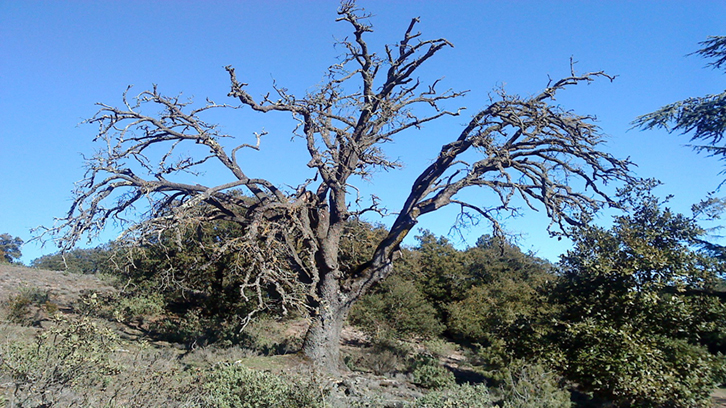Stem mortality and forest dieback in the Mediterranean holm oak forest

Higher air temperatures are projected globally for the coming decades, and climatic patterns around the world are changing: the intensity and duration of extreme weather, such heat waves, floods, and droughts, are predicted to increase. Higher rates of evapotranspiration in some semi-arid and Mediterranean areas subjected to seasonal drought would be induced by these higher temperatures, together with the current or even a lower amount of precipitation.
The annual stem mortality rate was measured in a holm oak forest located in Prades Mountains, during 20 consecutive years (1999-2019). We investigated the influence of annual climatic conditions on the intensity of stem mortality, and also the effect of two experimental treatments: 1) an experimental drought (15% decrease in the amount of soil moisture), was conducted to study tree mortality under the drier conditions expected during the forthcoming decades; 2) a selective stem thinning (25% of stems removal), was performed to study the possible amelioration of drought effects improving water and resources availability for the remaining stems.
Stem mortality was higher when mean annual temperature was higher and rainfall was lower, especially during spring and summer. Stem mortality was higher in holm oak (Quercus ilex), than in other co-occurring tall shrubs species such as mock privet or strawberry tree (Phillyrea latifolia or Arbutus unedo, respectively), better adapted to drier conditions. Drought treatment increased stem mortality especially in hotter and drier years, and holm oak was the species more affected by the drought treatment. On the other hand, the selective stem thinning strongly reduced stem mortality (especially in Q. ilex) by buffering the effects of climate change on the structure of this forest.
These results highlight a future increase of tree mortality and forest dieback, and a progressive substitution of the current dominant species of this forest, holm oak, by other tall shrub species more adapted to new climatic conditions. Some ecosystem services such as the amelioration of climate change by CO2 uptake will also be seriously affected. But selective stem thinning was also identified as an excellent tool for managing this forest in a changing climate: in addition to their benefits for forest conservation and functioning, selective thinning contributes to mitigate climate change due to an increase in the uptake of atmospheric CO2, enhancing photosynthetic activity. Selective thinning has also other indirect benefits such as decreasing the risk of forest fires and increasing human water supply, because a high stem density can favor the spread of forest fire due to the abundance of dead stems and branches, and highly dense vegetation consumes a lot of rainwater.
Romà Ogaya, Daijun Liu, Adrià Barbeta, Josep Peñuelas
Global Ecology Unit
CREAF-CEAB-CSIC - Universitat Autònoma de Barcelona
References
Ogaya, R., Liu, D., Barbeta, A., Peñuelas, J. 2020. Stem mortality and forest dieback in a 20-years experimental drought in a Mediterranean holm oak forest. Frontiers in Forests and Global Change 2: 89. doi: 10.3389/ffgc.201900089.


